CHRYSLER ASPEN 2008 2.G Manual PDF
Manufacturer: CHRYSLER, Model Year: 2008, Model line: ASPEN, Model: CHRYSLER ASPEN 2008 2.GPages: 479, PDF Size: 4.3 MB
Page 71 of 479
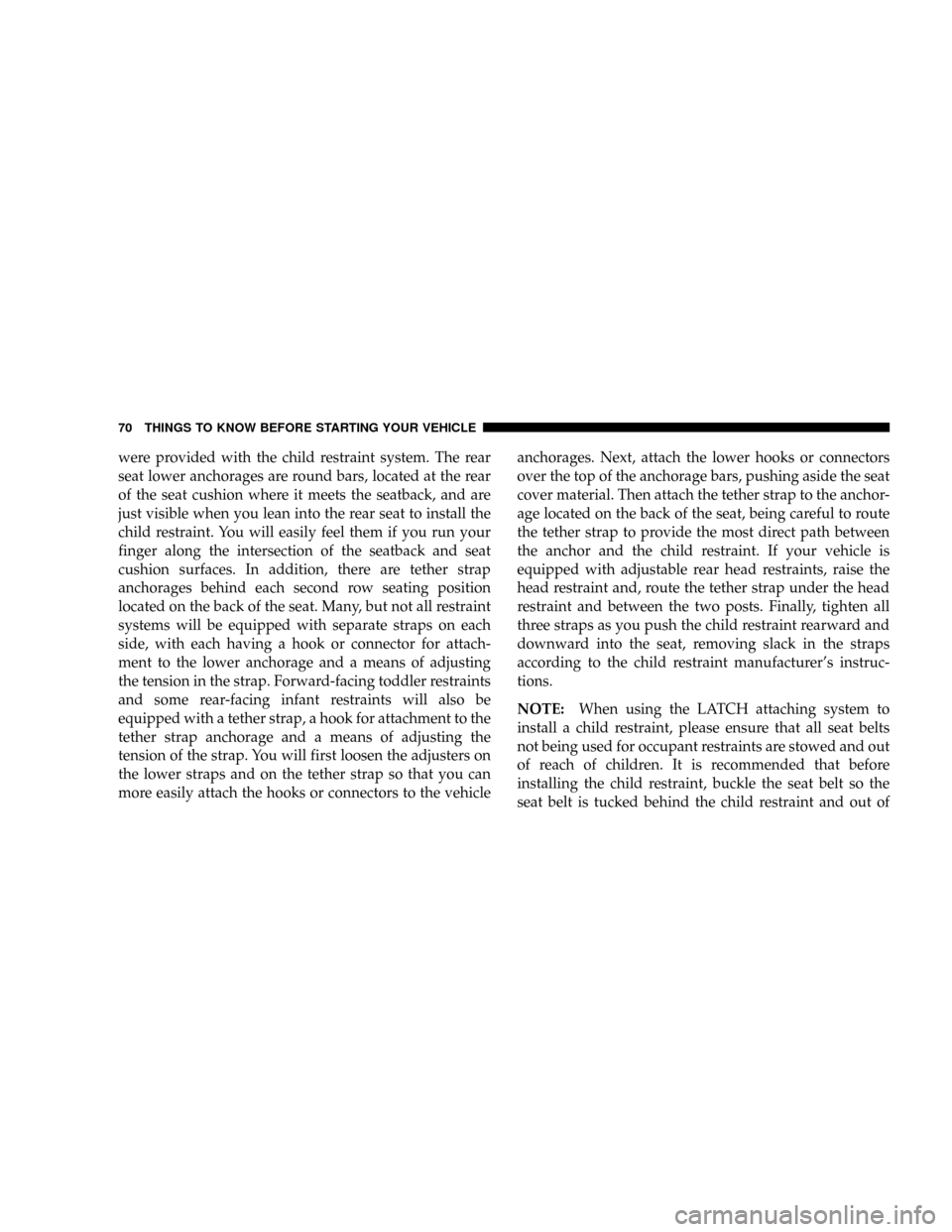
were provided with the child restraint system. The rear
seat lower anchorages are round bars, located at the rear
of the seat cushion where it meets the seatback, and are
just visible when you lean into the rear seat to install the
child restraint. You will easily feel them if you run your
finger along the intersection of the seatback and seat
cushion surfaces. In addition, there are tether strap
anchorages behind each second row seating position
located on the back of the seat. Many, but not all restraint
systems will be equipped with separate straps on each
side, with each having a hook or connector for attach-
ment to the lower anchorage and a means of adjusting
the tension in the strap. Forward-facing toddler restraints
and some rear-facing infant restraints will also be
equipped with a tether strap, a hook for attachment to the
tether strap anchorage and a means of adjusting the
tension of the strap. You will first loosen the adjusters on
the lower straps and on the tether strap so that you can
more easily attach the hooks or connectors to the vehicleanchorages. Next, attach the lower hooks or connectors
over the top of the anchorage bars, pushing aside the seat
cover material. Then attach the tether strap to the anchor-
age located on the back of the seat, being careful to route
the tether strap to provide the most direct path between
the anchor and the child restraint. If your vehicle is
equipped with adjustable rear head restraints, raise the
head restraint and, route the tether strap under the head
restraint and between the two posts. Finally, tighten all
three straps as you push the child restraint rearward and
downward into the seat, removing slack in the straps
according to the child restraint manufacturer's instruc-
tions.
NOTE:When using the LATCH attaching system to
install a child restraint, please ensure that all seat belts
not being used for occupant restraints are stowed and out
of reach of children. It is recommended that before
installing the child restraint, buckle the seat belt so the
seat belt is tucked behind the child restraint and out of
70 THINGS TO KNOW BEFORE STARTING YOUR VEHICLE
Page 72 of 479
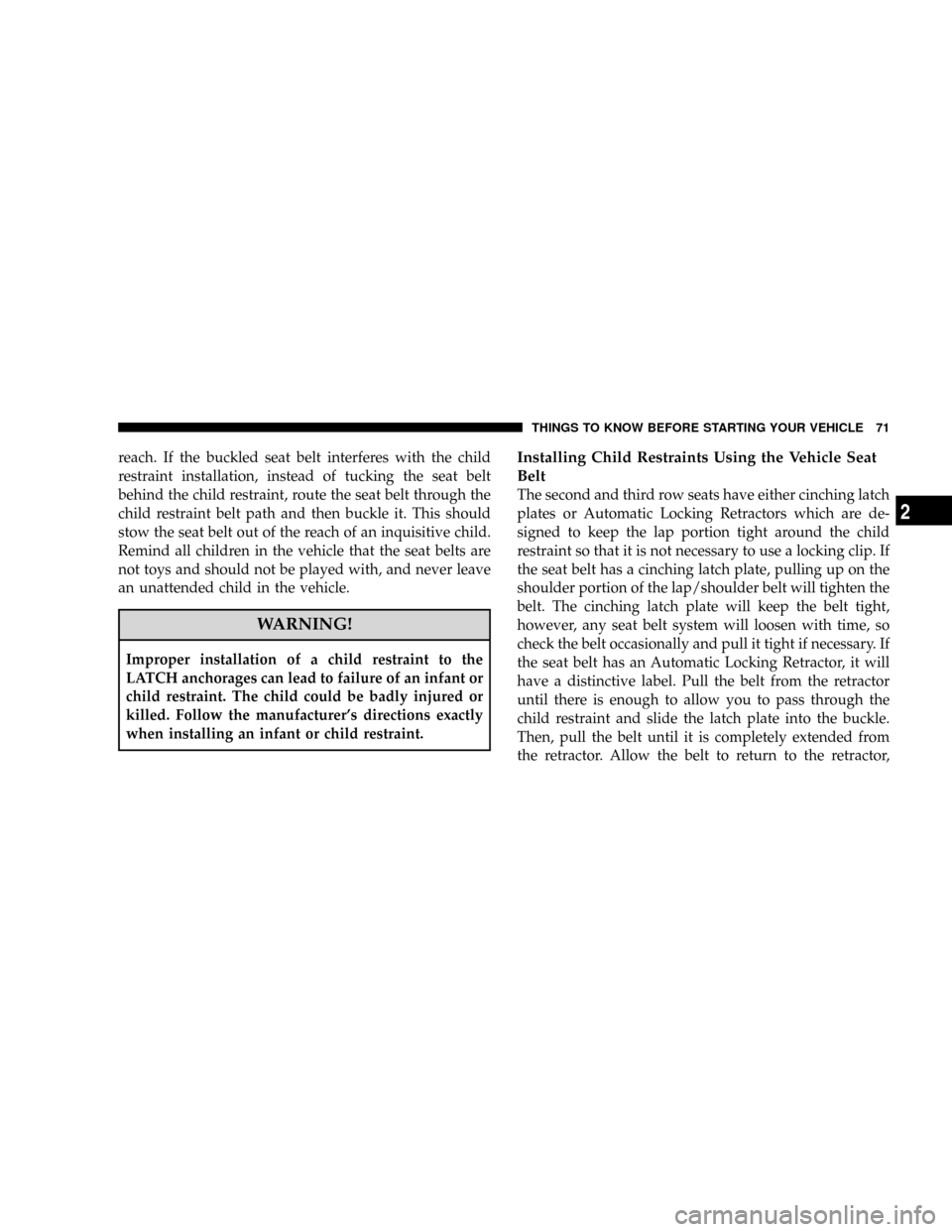
reach. If the buckled seat belt interferes with the child
restraint installation, instead of tucking the seat belt
behind the child restraint, route the seat belt through the
child restraint belt path and then buckle it. This should
stow the seat belt out of the reach of an inquisitive child.
Remind all children in the vehicle that the seat belts are
not toys and should not be played with, and never leave
an unattended child in the vehicle.
WARNING!
Improper installation of a child restraint to the
LATCH anchorages can lead to failure of an infant or
child restraint. The child could be badly injured or
killed. Follow the manufacturer's directions exactly
when installing an infant or child restraint.
Installing Child Restraints Using the Vehicle Seat
Belt
The second and third row seats have either cinching latch
plates or Automatic Locking Retractors which are de-
signed to keep the lap portion tight around the child
restraint so that it is not necessary to use a locking clip. If
the seat belt has a cinching latch plate, pulling up on the
shoulder portion of the lap/shoulder belt will tighten the
belt. The cinching latch plate will keep the belt tight,
however, any seat belt system will loosen with time, so
check the belt occasionally and pull it tight if necessary. If
the seat belt has an Automatic Locking Retractor, it will
have a distinctive label. Pull the belt from the retractor
until there is enough to allow you to pass through the
child restraint and slide the latch plate into the buckle.
Then, pull the belt until it is completely extended from
the retractor. Allow the belt to return to the retractor,
THINGS TO KNOW BEFORE STARTING YOUR VEHICLE 71
2
Page 73 of 479
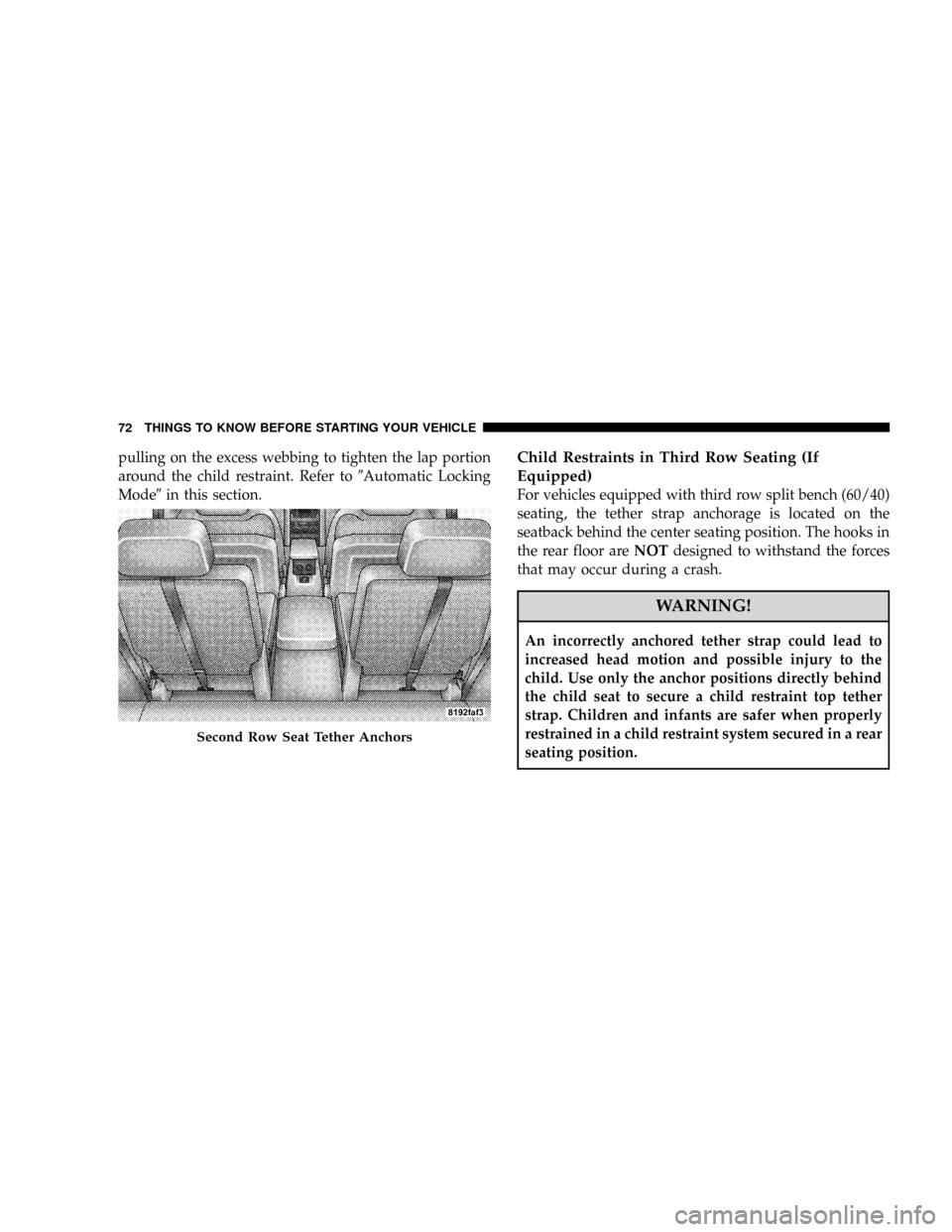
pulling on the excess webbing to tighten the lap portion
around the child restraint. Refer to9Automatic Locking
Mode9in this section.Child Restraints in Third Row Seating (If
Equipped)
For vehicles equipped with third row split bench (60/40)
seating, the tether strap anchorage is located on the
seatback behind the center seating position. The hooks in
the rear floor areNOTdesigned to withstand the forces
that may occur during a crash.
WARNING!
An incorrectly anchored tether strap could lead to
increased head motion and possible injury to the
child. Use only the anchor positions directly behind
the child seat to secure a child restraint top tether
strap. Children and infants are safer when properly
restrained in a child restraint system secured in a rear
seating position.
Second Row Seat Tether Anchors
72 THINGS TO KNOW BEFORE STARTING YOUR VEHICLE
Page 74 of 479

Child Restraint Tether Anchor
There are tether strap anchorages behind each seating
position in the second row and behind the center seating
position in the case of the third row seat (60/40) split
bench, if equipped. To install child restraint tether follow
these instructions:
1. Place the child restraint in the center seating position
of the third row of seats.
2. Route the tether strap under the head restraint and
between the two headrest posts.
3. Attach the tether strap hook of the child restraint to
the tether anchor located on the seatback and remove the
slack in the tether strap according to the manufacturer 's
instructions.
Third Row Seat Tether Anchor
THINGS TO KNOW BEFORE STARTING YOUR VEHICLE 73
2
Page 75 of 479
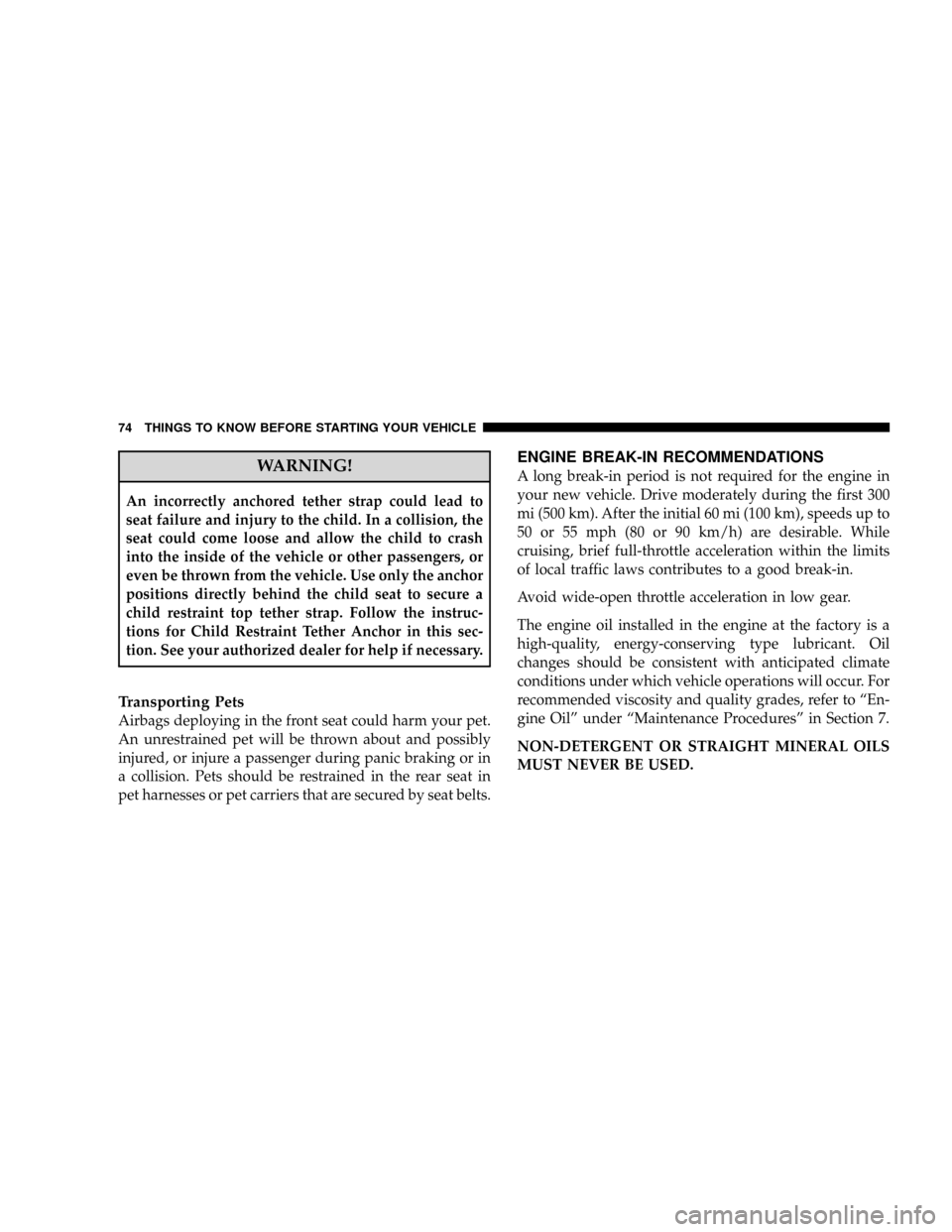
WARNING!
An incorrectly anchored tether strap could lead to
seat failure and injury to the child. In a collision, the
seat could come loose and allow the child to crash
into the inside of the vehicle or other passengers, or
even be thrown from the vehicle. Use only the anchor
positions directly behind the child seat to secure a
child restraint top tether strap. Follow the instruc-
tions for Child Restraint Tether Anchor in this sec-
tion. See your authorized dealer for help if necessary.
Transporting Pets
Airbags deploying in the front seat could harm your pet.
An unrestrained pet will be thrown about and possibly
injured, or injure a passenger during panic braking or in
a collision. Pets should be restrained in the rear seat in
pet harnesses or pet carriers that are secured by seat belts.
ENGINE BREAK-IN RECOMMENDATIONS
A long break-in period is not required for the engine in
your new vehicle. Drive moderately during the first 300
mi (500 km). After the initial 60 mi (100 km), speeds up to
50 or 55 mph (80 or 90 km/h) are desirable. While
cruising, brief full-throttle acceleration within the limits
of local traffic laws contributes to a good break-in.
Avoid wide-open throttle acceleration in low gear.
The engine oil installed in the engine at the factory is a
high-quality, energy-conserving type lubricant. Oil
changes should be consistent with anticipated climate
conditions under which vehicle operations will occur. For
recommended viscosity and quality grades, refer to ªEn-
gine Oilº under ªMaintenance Proceduresº in Section 7.
NON-DETERGENT OR STRAIGHT MINERAL OILS
MUST NEVER BE USED.
74 THINGS TO KNOW BEFORE STARTING YOUR VEHICLE
Page 76 of 479

A new engine may consume some oil during its first few
thousand miles (kilometers) of operation. This is a nor-
mal part of the break-in and is not an indication of
difficulty.SAFETY TIPS
Exhaust System
WARNING!
Exhaust gases contain carbon monoxide, an extremely
toxic gas that by itself is colorless and odorless. To
avoid inhaling these gases, the following precautions
should be observed:
²Do not run the engine in a closed garage or in
confined areas any longer than needed to move your
vehicle in or out of the area.
²It may be necessary to sit in a parked vehicle with the
engine running for more than a short period. If so,
adjust your climate control system to force outside
air into the vehicle. Set the blower at high speed and
the controls in any position except OFF or RECIRC.
²The best protection against carbon monoxide entry
into the vehicle body is a properly maintained en-
gine exhaust system.
THINGS TO KNOW BEFORE STARTING YOUR VEHICLE 75
2
Page 77 of 479
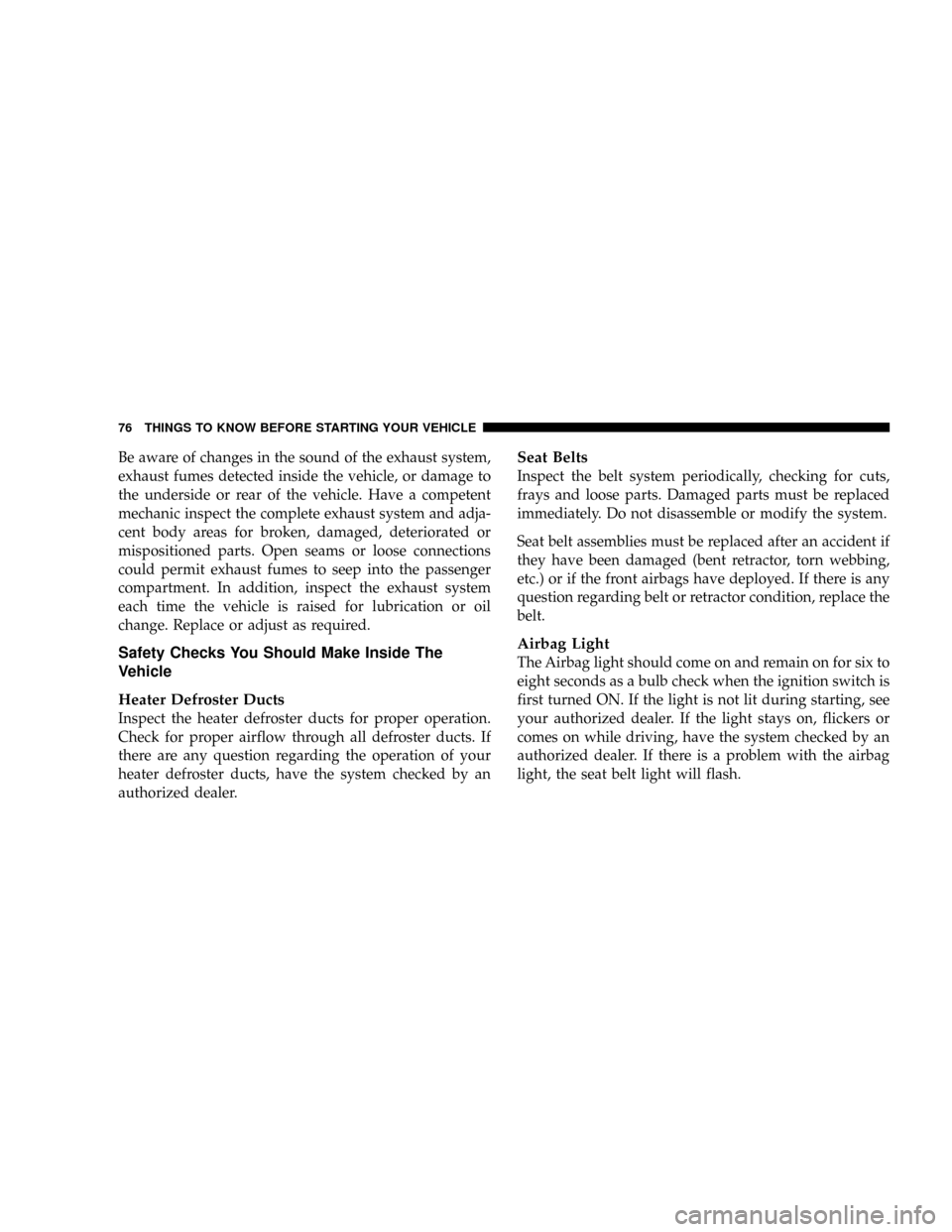
Be aware of changes in the sound of the exhaust system,
exhaust fumes detected inside the vehicle, or damage to
the underside or rear of the vehicle. Have a competent
mechanic inspect the complete exhaust system and adja-
cent body areas for broken, damaged, deteriorated or
mispositioned parts. Open seams or loose connections
could permit exhaust fumes to seep into the passenger
compartment. In addition, inspect the exhaust system
each time the vehicle is raised for lubrication or oil
change. Replace or adjust as required.
Safety Checks You Should Make Inside The
Vehicle
Heater Defroster Ducts
Inspect the heater defroster ducts for proper operation.
Check for proper airflow through all defroster ducts. If
there are any question regarding the operation of your
heater defroster ducts, have the system checked by an
authorized dealer.
Seat Belts
Inspect the belt system periodically, checking for cuts,
frays and loose parts. Damaged parts must be replaced
immediately. Do not disassemble or modify the system.
Seat belt assemblies must be replaced after an accident if
they have been damaged (bent retractor, torn webbing,
etc.) or if the front airbags have deployed. If there is any
question regarding belt or retractor condition, replace the
belt.
Airbag Light
The Airbag light should come on and remain on for six to
eight seconds as a bulb check when the ignition switch is
first turned ON. If the light is not lit during starting, see
your authorized dealer. If the light stays on, flickers or
comes on while driving, have the system checked by an
authorized dealer. If there is a problem with the airbag
light, the seat belt light will flash.
76 THINGS TO KNOW BEFORE STARTING YOUR VEHICLE
Page 78 of 479
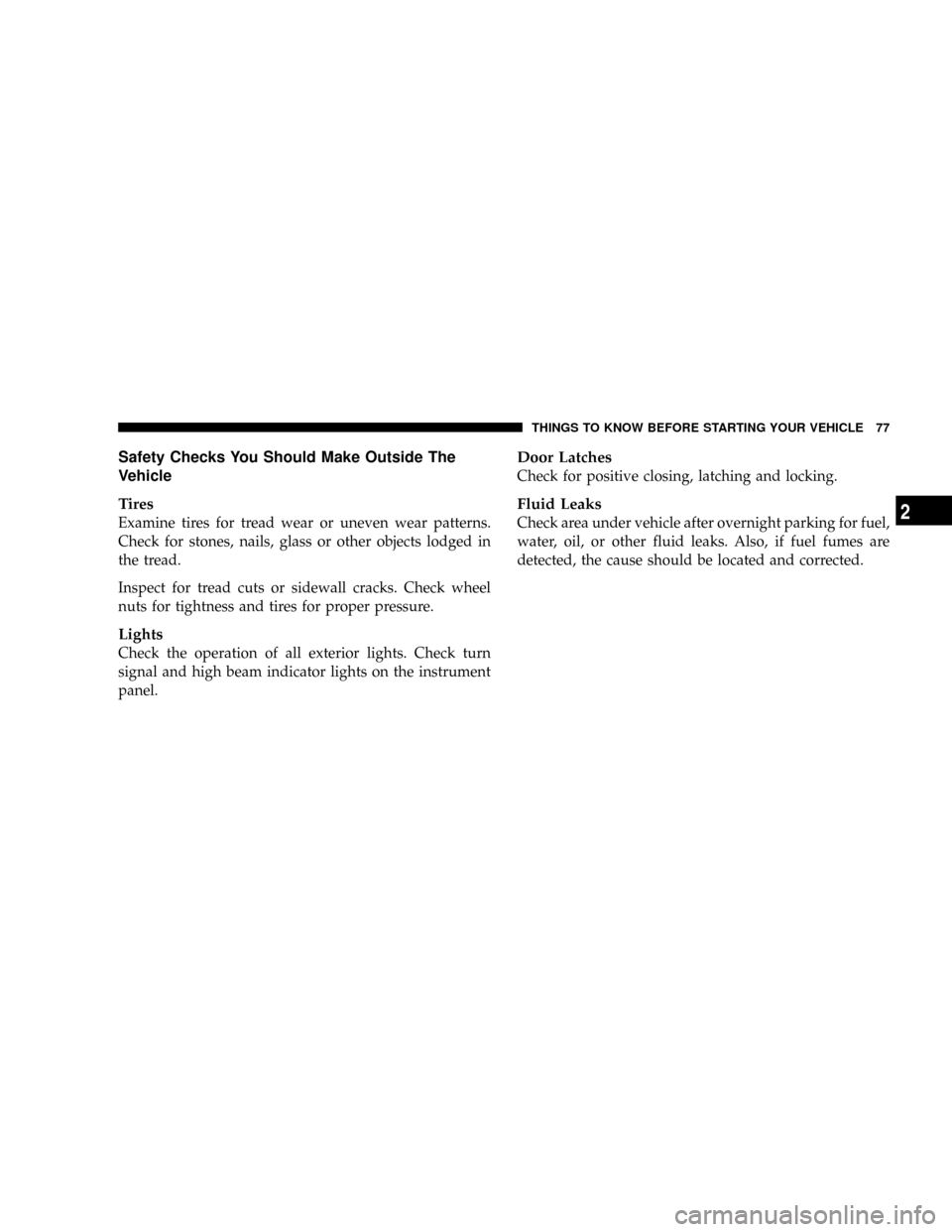
Safety Checks You Should Make Outside The
Vehicle
Tires
Examine tires for tread wear or uneven wear patterns.
Check for stones, nails, glass or other objects lodged in
the tread.
Inspect for tread cuts or sidewall cracks. Check wheel
nuts for tightness and tires for proper pressure.
Lights
Check the operation of all exterior lights. Check turn
signal and high beam indicator lights on the instrument
panel.
Door Latches
Check for positive closing, latching and locking.
Fluid Leaks
Check area under vehicle after overnight parking for fuel,
water, oil, or other fluid leaks. Also, if fuel fumes are
detected, the cause should be located and corrected.
THINGS TO KNOW BEFORE STARTING YOUR VEHICLE 77
2
Page 79 of 479
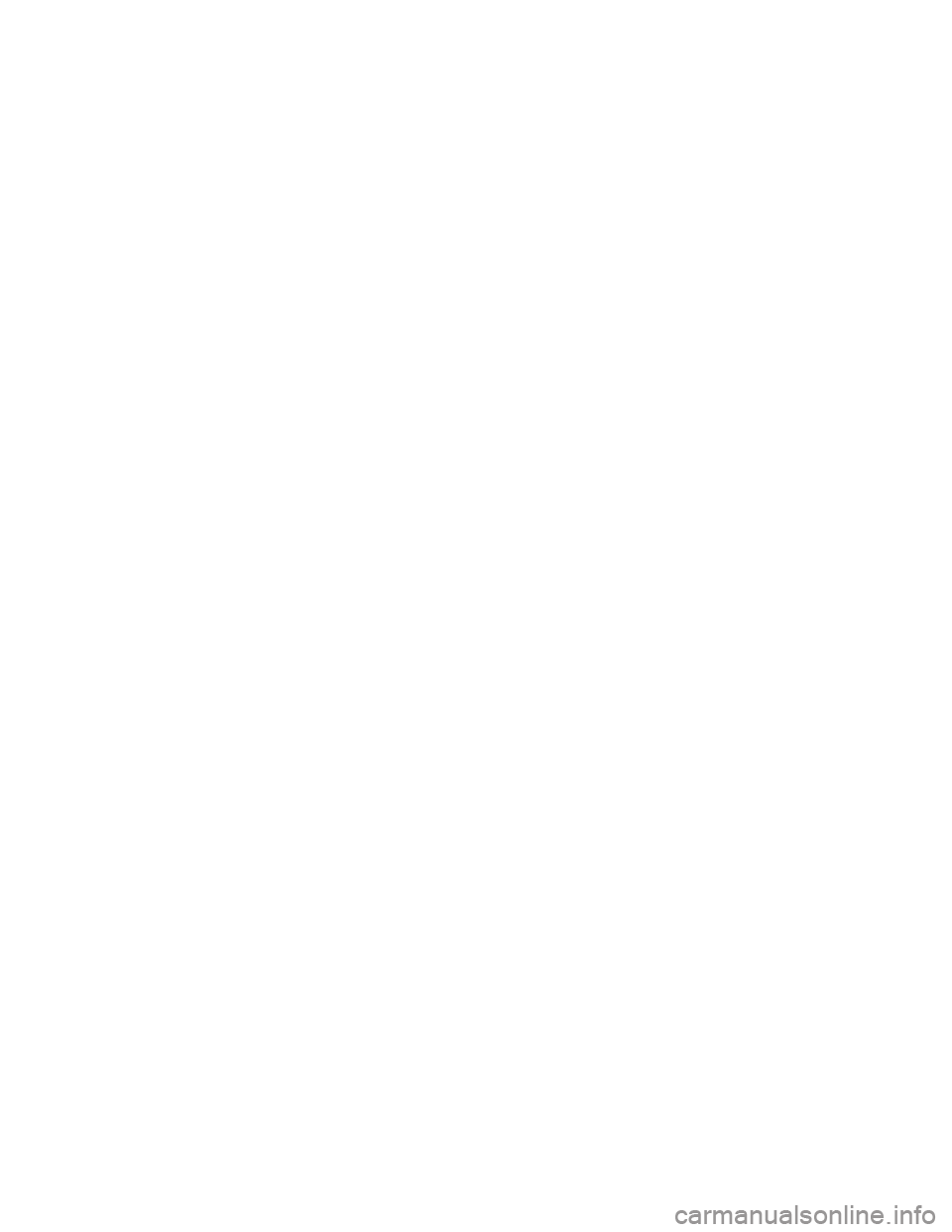
Page 80 of 479
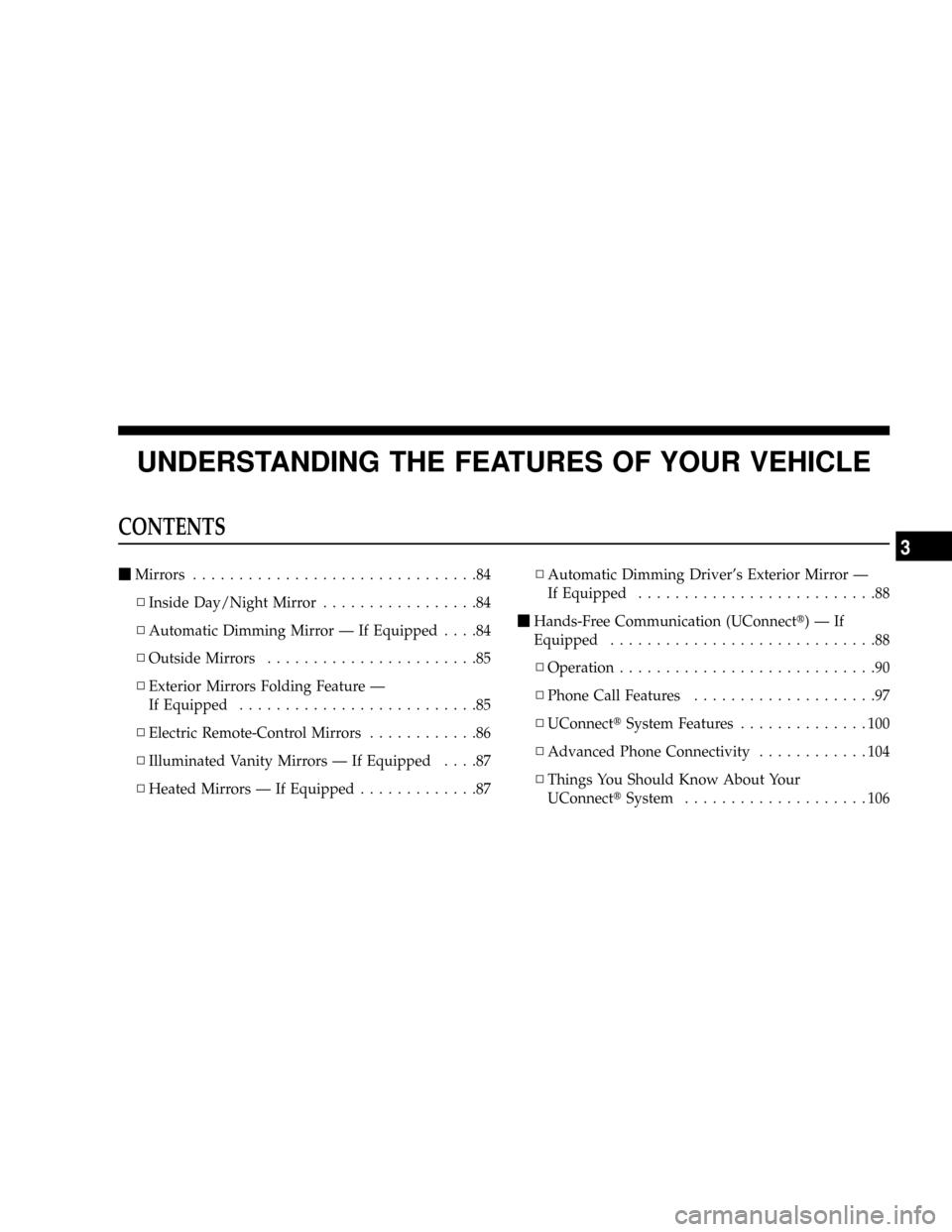
UNDERSTANDING THE FEATURES OF YOUR VEHICLE
CONTENTS
mMirrors...............................84
NInside Day/Night Mirror.................84
NAutomatic Dimming Mirror Ð If Equipped....84
NOutside Mirrors.......................85
NExterior Mirrors Folding Feature Ð
If Equipped..........................85
NElectric Remote-Control Mirrors............86
NIlluminated Vanity Mirrors Ð If Equipped....87
NHeated Mirrors Ð If Equipped.............87NAutomatic Dimming Driver's Exterior Mirror Ð
If Equipped..........................88
mHands-Free Communication (UConnectt)ÐIf
Equipped.............................88
NOperation............................90
NPhone Call Features....................97
NUConnecttSystem Features..............100
NAdvanced Phone Connectivity............104
NThings You Should Know About Your
UConnecttSystem....................106
3